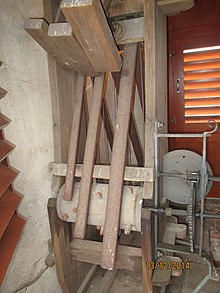Baton bells
A stick chime is an inexpensive replacement for church bells , first introduced in North America, England and 1830 in Germany in the 19th century . It consists of several steel rods that are struck with a hammer. The signal generator, which usually produces a triad , is, according to the Hornbostel-Sachs system, a baton game, i.e. a polyphonic, immediately struck idiophone . Baton games are related to the bat games, which most metallophones belong to.
In the 19th century, stick bells usually had three cast steel sticks, which were fastened vertically next to each other in a wooden frame and, triggered by a crank mechanism, were struck by wooden hammers. They were preferably used in smaller churches with simply constructed bell towers . The sound quality was significantly worse and the volume was lower than with church bells made of bronze , but the sound was already considered usable with a stick weighing only 20 kilograms.
The only stick bells preserved in Germany is in the St. Jacobus Church in the municipality of Serno in the district of Wittenberg . It was designed by the blacksmith Johann Gottlieb Samuel Sachsenberg (1782–1844) for the church, consecrated in 1830. Two more stick bells of the same type are no longer preserved. One of these, with four bars, was made by the master blacksmith in 1832 for the Catholic castle church in Köthen (also in Saxony-Anhalt ). It was still in use around 1900. The third bollard from 1835 was ordered by a merchant who sent it to Italy. Sachsenberg demanded 36 thalers for the bells from Serno with bars of 10, 15 and 20 kilograms and 560 thalers for the larger bells from Köthen. Its four rods weighed 25, 35, 60 and 90 kilograms. It is known from the third bang that the three bars weighed 20, 30 and 40 kilograms and were sold for 150 thalers.
The rods of the Serno bells are V-shaped angled at an angle of 68 ° and suspended freely from leather straps. The legs have dimensions of 775 × 60 × 12 mm, 885 × 50 × 14 mm and 965 × 38 × 16 mm. The six hammers located above are triggered by the camshaft via a lever mechanism. The bells are almost in their original condition, only the cams of the camshaft have been refurbished in the meantime.
At the Berlin Customs Union Exhibition in 1844, the industrialist Alfred Krupp showed the three-tone bells made by his company Krupp-Gussstahlfabrik, along with other cast-iron products such as cast-iron rollers for coin production. Above all, the company made it known to trade fair visitors because it rang every day at the beginning and end of the viewing period. Krupp praised his bells as an inexpensive alternative to bells for poorer church communities. Three iron bars, bent in the shape of a horseshoe, were suspended from a wooden pole with the legs facing downwards. The jury of the exhibition praised the “intense, pleasant sound” of the 400 kilogram instrument.
The American magazine The Galaxy in 1873 also highlighted the low cost and the simpler production , which spoke of a certain spread of stick bells in English and German churches. The price for a stick chime with three to four sticks up to 100 kilograms was therefore about a fifth of bells in England. On July 28, 1873, according to the American monthly magazine Popular Science, an English patent office issued a provisional patent to Ferdinand Rahles and James Dixon Mackenzie for stick bells including drive mechanisms for use in churches. The hammers in the bell towers of the design submitted for patent should be excited from below via ropes or some other mechanical connection. The construction drawing was not detailed enough for a registered patent.
Related to stick bells are tube bells, which are known today as tubular bells , instrumental bells or beater bells , and which used to replace bells in orchestras. Instead of the massive rods, material-saving and resonance-enhancing tubes are attached. Richard Wagner demanded four deep-sounding bronze tubes for the performance of Parsifal in Bayreuth in 1882 . As a replacement for church bells, tubular bells were used relatively often in England in the second half of the 19th century, possibly starting from France.
An older replacement for church bells is the semantron used in Orthodox churches , a solid wooden pickguard that was struck with one or two wooden hammers. Since the pre-Islamic period, Christians in Arab countries have beaten the naqus, which has now disappeared, with a flexible baton.
Web links
- Serno St. Jakobus Church steel bar peal. Youtube video
Individual evidence
- ↑ Edmund Külp : Textbook of Experimental Physics . Volume 2. Darmstadt 1858, p. 81 ( Google Books )
- ^ Sachsenberg in the German biography
- ^ The bells of Serno (DdM 2005-02). ( Page no longer available , search in web archives ) Info: The link was automatically marked as defective. Please check the link according to the instructions and then remove this notice. Bicycle tours Saxony-Anhalt
- ↑ Paul de Wit (ed.): Journal for instrument making. Central organ for the interests of the manufacture of musical instruments and the trade. Volume 21, 1900–1901, pp. 137–139 ( Bayrische Staatsbibliothek )
- ↑ Barbara Wolbrink: Krupp and the public in the 19th century. Self-portrayal, public perception and social communication ( series of publications on the journal for corporate history , volume 6). CH Beck, Munich 2000, p. 92
- ^ The Galaxy , Vol. 16, No. 6, December 1873, p. 852
- ↑ Popular Science Monthly, Volume 6, December 1874, pp. 252f
- ^ History of the Firm. Church Bells of Warwickshire
